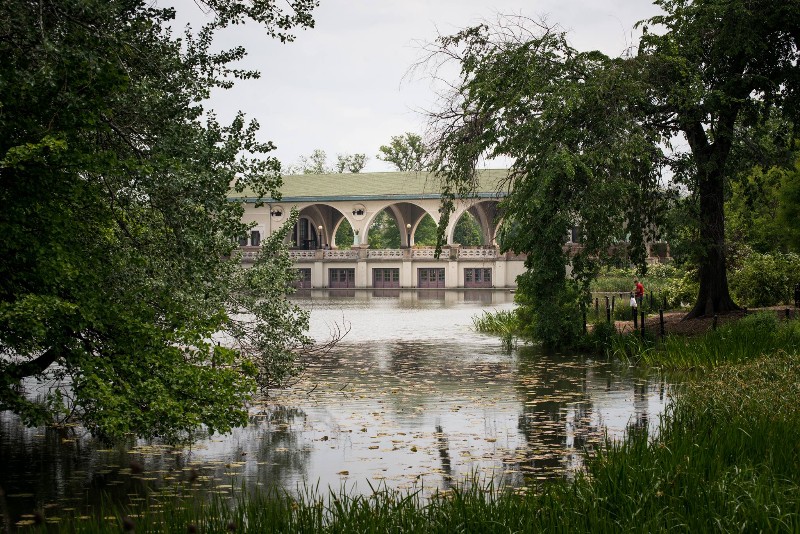Located in the heart of the Humboldt Park Community, Humboldt Park totals 219 acres and features a field house with fitness center, two gymnasiums, meeting rooms and an inland beach. Additional green features of our facility include: an artificial turf soccer field, junior soccer field, lagoon, a replica of the Chicago Cubs stadium, “Little Cubs Field,” and a stable building, now the Puerto Rican Arts and Culture Museum and baseball fields, tennis courts and playgrounds.
Many of these spaces are available for rental. The grand ballroom in the field house is often the site of wedding receptions and graduation parties. The outdoor soccer fields and Little Cubs Field are often the site of competitive sports tournaments.
Park-goers can play baseball, soccer or tennis at the facility. On the cultural side, the Park is host to the Latin Jazz Festival, the Puerto Rican Festival. The Park is also the site of a wind turbine filtration system for the lagoons. After school programs are offered throughout the school year, and in the summer youth attend the Park District’s popular six-week day camp. Specialty camps are offered in the summer as well, and include baseball camp.
In addition to programs, Humboldt Park hosts fun special events throughout the year for the whole family.
The park was named for Alexander Von Humboldt , a German naturalist and geographer famed for his five-volume work Cosmos: Draft of a Physical Description of the World. His single visit to the United States did not include Chicago. The creation of Humboldt and several other Westside parks provided beauty, linked together via Chicago’s historic boulevard system.
With the support of the community, Puerto Rican leaders in Chicago leased the historic Humboldt Park stables near Paseo Boricua that house the Institute of Puerto Rican Arts and Culture. It is the only museum in the nation that is completely dedicated to the history of Puerto Rican culture.
Parking/Directions
For directions using public transportation visit www.transitchicago.com.History
In 1869, shortly after the creation of the West Park System, neighborhood residents requested that the northernmost park be named in honor of Baron Freidrich Heinrich Alexander Von Humboldt (1759-1859), the famous German scientist and explorer. Two years later, completed plans for the entire ensemble of Humboldt, Garfield, and Douglas parks and connecting boulevards were completed by William Le Baron Jenney, who is best known today as the father of the skyscraper. Having studied engineering in Paris during the construction of that city’s grand park and boulevard system in the 1850s, Jenney was influenced by French design. The construction of Humboldt Park was slow, however, and the original plan was followed only for the park’s northeastern section. Jens Jensen, a Danish immigrant who had begun as a laborer, worked his way up to Superintendent of Humboldt Park in the mid-1890s. Unfortunately, the West Park System was entrenched in political graft at the time. The commissioners fired Jensen in 1900 because of his efforts to fight the corruption. Five years later, during major political reforms, new commissioners appointed him General Superintendent and Chief Landscape Architect. Deteriorating and unfinished areas of Humboldt Park allowed Jensen to experiment with his evolving Prairie style. For instance, Jensen extended the park’s existing lagoon into a long meandering “prairie river.” Inspired by the natural rivers he saw on trips to the countryside, Jensen designed hidden water sources that supplied two rocky brooks that fed the waterway. Nearby he created a circular rose garden and an adjacent naturalistic perennial garden. Jensen designated an area diagonally across from the rose garden as a a music court for dances, concerts and other special events. He commissioned Prairie School architects Schmidt, Garden, and Martin to design an impressive boat house and refectory building which still stands at one end of the historic music court. In 1928, the West Park Commission contructed a fieldhouse in Humboldt Park. The structure was designed by architects Michaelsen and Rognstad, who were also responsible for other notable buildings including the Garfield Park Gold Dome Building, the Douglas and LaFolette Park Fieldhouses, and the On Leong Chinese Merchant’s Association Building in Chinatown. In 1934, Humboldt Park became part of the Chicago Park District, when the city’s 22 independent park commissions merged into a single citywide agency.No Records Found
Sorry, no records were found. Please adjust your search criteria and try again.
Google Map Not Loaded
Sorry, unable to load Google Maps API.
- Save as a Fave!
